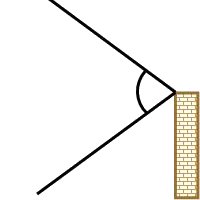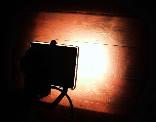Home & Commercial 'Security'* Floodlighting
- How to install a 'security' floodlight
- Interactive illustration of glare caused by floodlights
- The dangers and problems caused by such 'security' floodlights (including how such lighting can aid criminals)
- The response of DIY stores
- Additional notes
How-to install a 'security' floodlight
- Use low power and direct the light downwards
- Make sure the light does not shine where it is not needed - especially not into neighbouring homes, onto neighbouring property, or into the sky
Both these steps will make criminals more visible. The UK Government Crime-prevention website states: "The form of lighting currently found many domestic locations is a 250 or 500 watt tungsten halogen floodlight controlled by a movement sensor (passive infra-red, PIR). Increasingly, over-bright and misdirected LED lights cause problems of glare, environmental disruption and skyglow. This is unfortunate, as in many locations it is inappropriately installed and other forms of lighting could make for a better choice.". See also, the advice available from the Institute of Lighting Professionals [pdf version].
Interactive image: Instructions for use
Please hover your mouse cursor over the angles on the left hand side (below) to view the effects of installing a floodlight at various angles
Select angle     |
 The view |

 Floodlight fixing |
 Schematic Diagram with a 72o opening angle Note: Some floodlights have a much larger spread, as below |
Angle
 | At an angle of 90 degrees from the vertical, the light is shining directly outwards, making it impossible for onlookers to see any criminal activity. |
 | At 67o, the problems persist as at 90 degrees, making your 'security' light a serious 'security' risk. |
 | The floodlight has an opening angle of 72 degrees, and so the light needs to be angled at less than half that (i.e. less than 36o) to illuminate the background (in this case, a wall). |
 | At 22o, the floodlight begins to become a 'security' aid. The house wall is illuminated, and so any intruder is highlighted against the background even if (as in this case) the background (i.e. the gate) is dark. However, when standing closeby, the light source is still visible, which impedes the ability of a nearby witness to identify an intruder. |
 | Pointing a floodlight directly downwards is the best solution. The background wall is illuminated, and the bulb of the floodlight is no longer visible, making it easier on the eye. However, the floodlight is still over-powered (in this case, a 500W bulb); such a bulb will always generate strong shadows for people to hide in. The best overall solution is a floodlight pointing directly downwards whilst using a low powered bulb (60-120W will aid onlookers, without generating glare). |
The disadvantages of using home "security" floodlights
- In Oxfordshire, a man was hit by a car and killed after a 'security' floodlight temporarily blinded the driver. A bright floodlight, shining from a pub, had obscured his vision. The police carried out a reconstruction of the accident; a policeman noted "When I was driving towards the scene, the officer standing where Mr Smithson [the deceased] would have been was barely visible because of the 'security' light." [source: The Oxford Mail]
- According to the UK Government's Home 'Security' & Crime Reduction website:
- "Harsh, glaring floodlights are not a deterrent to criminals;"
- Floodlights can increase the fear of crime amongst the most vulnerable
- Poorly installed floodlights can aid criminals by blinding onlookers with glare (as demonstrated above) - criminals know this and can use such lights as a cloak. See Jay Ryan's Skywise cartoon (as published in the Sky & Telescope).

- Floodlights are extremely overpowered. A 50W bulb is adequate, yet such floodlights usually contain a 500W bulb! For comparison, the Smalls lighthouse uses a 35W bulb and is visible 21 miles away! [Source: wikipedia and the BBC News]
- Such lights are either on continuously, or are easily triggered by PIR sensors (cats and the wind being common triggers). In both situations the lights are repeatedly "crying-wolf" throughout the night, such that neighbours will try to ignore the lights being on (yet again).
- Lights can help criminals see what they are doing, and help them to see an escape route in what would otherwise be unfamiliar surroundings. Burglars no longer need to carry a torch!
Ironically, there is no evidence that installing a "security floodlights" will make any area more secure; some people have been broken into directly beneath such floodlights. - The brighter the light, the darker any shadows will be in comparison - hence, a floodlight actually provides hiding places for intruders. Some claim that floodlights coming on have a "shock value", but intruders can deliberately trigger a floodlight, hide in a shadow, and look for any reaction while familiarising themselves with the area. Such testing of the water also generates a cry-wolf situation, causing any neighbours to assume there is no danger and so turn a blind eye to any subsequent triggers.
- The distribution of light from such floodlights is poor, being too bright close to the light, and too faint further from it. Better lights exist.
- Such bright lights advertise from afar that people are trying to protect something from being stolen. This is especially true in rural areas. Keeping your goods and property out of sight is probably a better tactic. Lights in secluded areas are just that: nobody can see what the criminal is doing, and he has a courtesy light to illuminate his activities; is a back garden light on at night helping you, the police or the burglar?
- The Parliamentary Select committee on Science and Technology in October 2003 called for an end to the retail of 500W "security" lights, and for the nuisance that they cause to be classified as actionable in law.
- We estimate that such 'security' floodlights in the UK alone use up 70 million kW hr per year, costing some (at 5p/kWhr) £3.5 million and producing 70,000 tonnes of CO2 pollution. Remember - 90% of all these numbers are simply waste, since an (efficient) 50W bulb can do a better job of a 500W over-the-top floodlight.
See also our lighting and crime webpage for more information.
The response of the DIY stores
Since a 500W lamp is 14 times brighter than the Small's lighthouse, and we are all supposed to be saving energy these days, CfDS has been in dialogue with several of the major DIY/household goods retailers, with a view to having them phase out 500W lights and sell more lights (e.g. the Astrica) which shine preferentially downwards and help preserve the stars. Surprisingly, we have had little success. One manufacturer is even selling lamps labelled "sky-friendly", though they manifestly are not!
The only retailer showing any interest has been B & Q. By promoting products, in particular the Astrica range, which have been designed with the specific intention of reducing stray light, B&Q have been a willing partner in supporting the CfDS campaign. Unfortunately however, B&Q and most other DIY stores, continue to sell lighting that is, as the Government states, "...the most inappropriate form of lighting available."
Additional notes
- * The word 'security' is in quotation marks because there is no conclusive evidence that lighting makes an area more secure. Lit premises as well as darkened ones are broken into, and crimes are routinely committed beneath lights. Lights certainly assists a criminal to see what to do and how to escape, and some 'security' lighting assists the criminal by blinding potential witnesses and cloaking the intruders' activity.
- The floodlight in the photographs at the top of this page has a 72 degree opening angle, although some floodlights have a much greater spread (the floodlight pictured below has an opening angle of over 100 degrees)
- All the photographs in the interactive demonstration above, were taken with a digital SLR camera, with auto-exposure. This mimics how the human eye reacts to light levels.
- At high light levels the pupil of your eye will shrink to prevent damage, reducing the amount of light that hits the retina.
- Similarly, at high light levels the exposure time of the camera will shrink to prevent damage, reducing the amount of light that hits the camera's detector.
- The floodlights do have one saving grace; they have a very well defined edge in their light opening angle, as shown in the photographs to the right.



